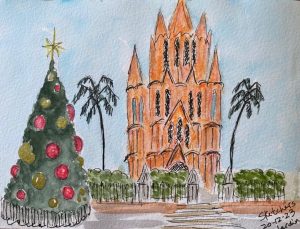Eight years ago this month I emigrated to Mexico, and I count this decision as one of my life’s best. Every day for the past eight years I’ve been thankful to be here.
It wasn’t an easy move; major life upheavals rarely are. I retired from teaching at UNM, rented my furnished one-bedroom condo in Taos, gave away or tossed the majority of my belongings, and packed only my life’s necessities: some clothes and shoes and toiletries, some precious books, my sewing machine and sewing supplies, some can’t-live-without kitchen equipment, my watercolor paint sets and pads, blank notebooks and journals, a family photo album, and my MacBook Air.
I flew into the Leon, Mexico, airport in December 2015 with two plastic bins containing everything I owned, ready to begin the last chapter of my life in beautiful San Miguel de Allende unencumbered by old stuff. I, like countless others in my age group, had learned (the hard way?) how to downsize, how to close big old doors and walk by faith toward smaller new ones, whether those new doors were in another state or another country.
In my weekly WOW blogposts since then, I’ve shared with readers from time to time what it’s been like to live here as a permanent resident – the frequent highs, occasional lows, and daily pleasures of life in San Miguel. Last night I reviewed some of those posts in my WOW archives and decided to share just one of them with you here to mark this eight-year anniversary.
This post was published in February 2016, just three months after I’d arrived. Everything I wrote in this WOW post then still holds true for me now. Viva (long live) México!
Mother Country
Mexico is not my mother country, but I’m beginning to think of it as motherly — motherly in the best sense — warm, patient, tolerant, forgiving, and accepting, even toward adoptees, like me.
When friends in the States ask how and why I’m liking my new life in Mexico, I sometimes recite my ABC’s: Affordability… Beauty… and Climate… But when I dig deeper into my reasons, it’s the “motherly” aspect that I find at the core. I feel embraced by an old, wise, feminine spirit here, and I’m basking in that nurturance.
I know I’m a newbie, but I think I’m also fairly clear-sighted. All countries, like the human beings that inhabit and run them, are flawed; and Mexico, as anyone who reads newspapers knows, is no exception. I’m not so naïve as to think Mexico is perfect – or even superior to anywhere else in all ways. I’m just saying it suits me, and I’m grateful for Mexico’s motherly embrace.
Some refer to Mexico as a “developing country” (an imperious term that always rankles me).But in all its development and modernity, Mexico hasn’t, it seems to me, abandoned its ancient traditions, including respect for elders. Every time I take a bus, for example, I observe a young person relinquishing his or her seat for an old person, without, it appears, a second thought.
I’ve only lived in San Miguel de Allende three months so far, but already I’ve met a number of older, single gringas like myself who feel the way I do. Without prompting, they happily say, “Yes, I live here now, and I plan to die here.”
This remark reminds me of U.S. inaugural poet Richard Blanco’s poem, “Mother Country,” about his mother’s emigration from Cuba in 1968, when she was seven months pregnant with him. The last lines of the poem are his mother’s words to him after a lifetime in the United States:
“You know, mijo, it isn’t where you’re born that matters, it’s where you choose to die – that’s your country.”
~ ~ ~ ~ ~ ~ ~ ~ ~ ~
Seasons Greetings from beautiful San Miguel!

~ ~ ~ ~ ~ ~ ~ ~ ~ ~ ~
For a few other WOW posts relating to my move to SMA eight years ago, go to:
